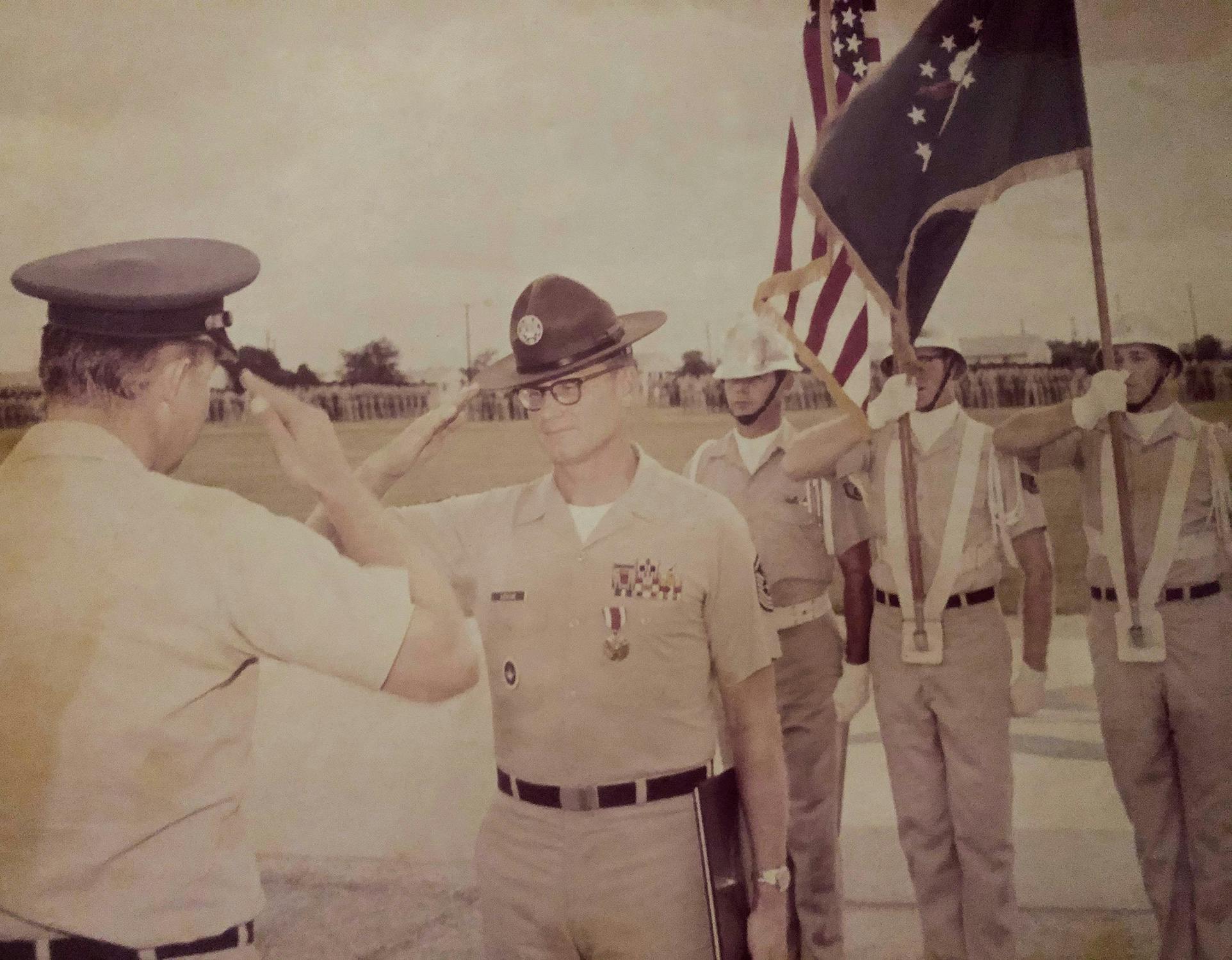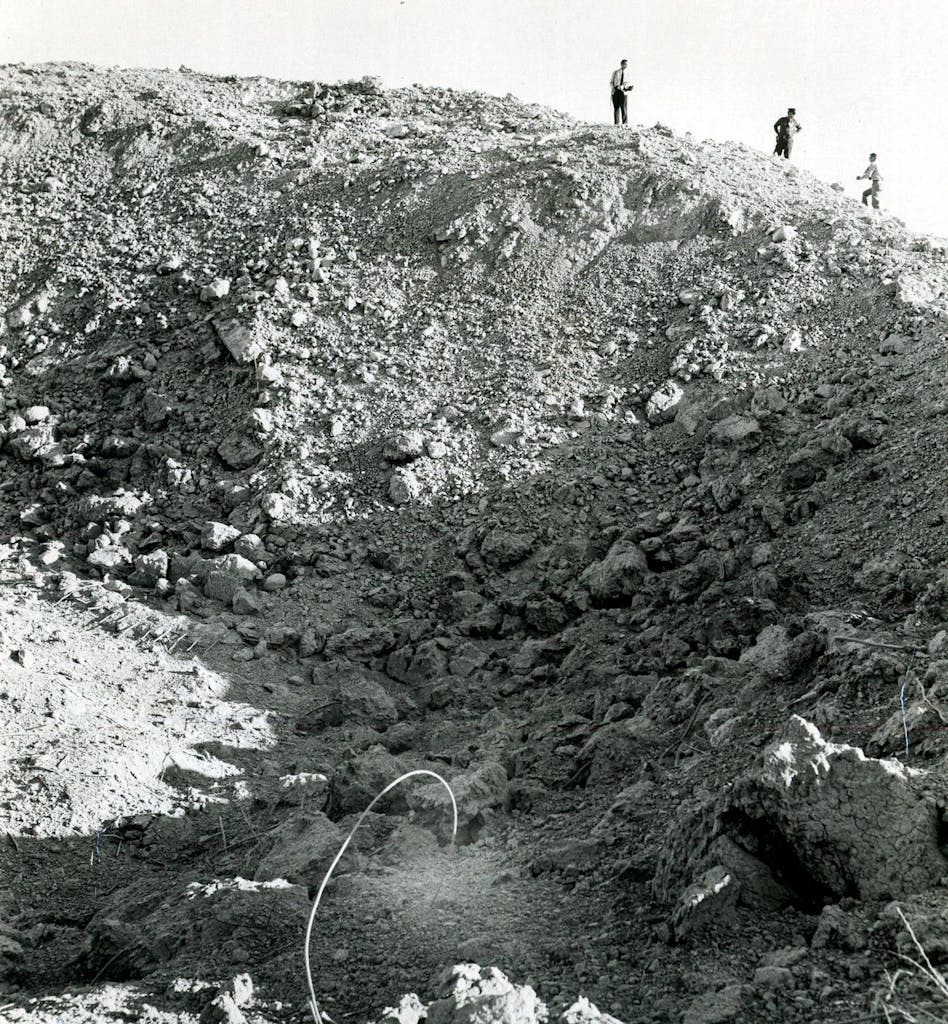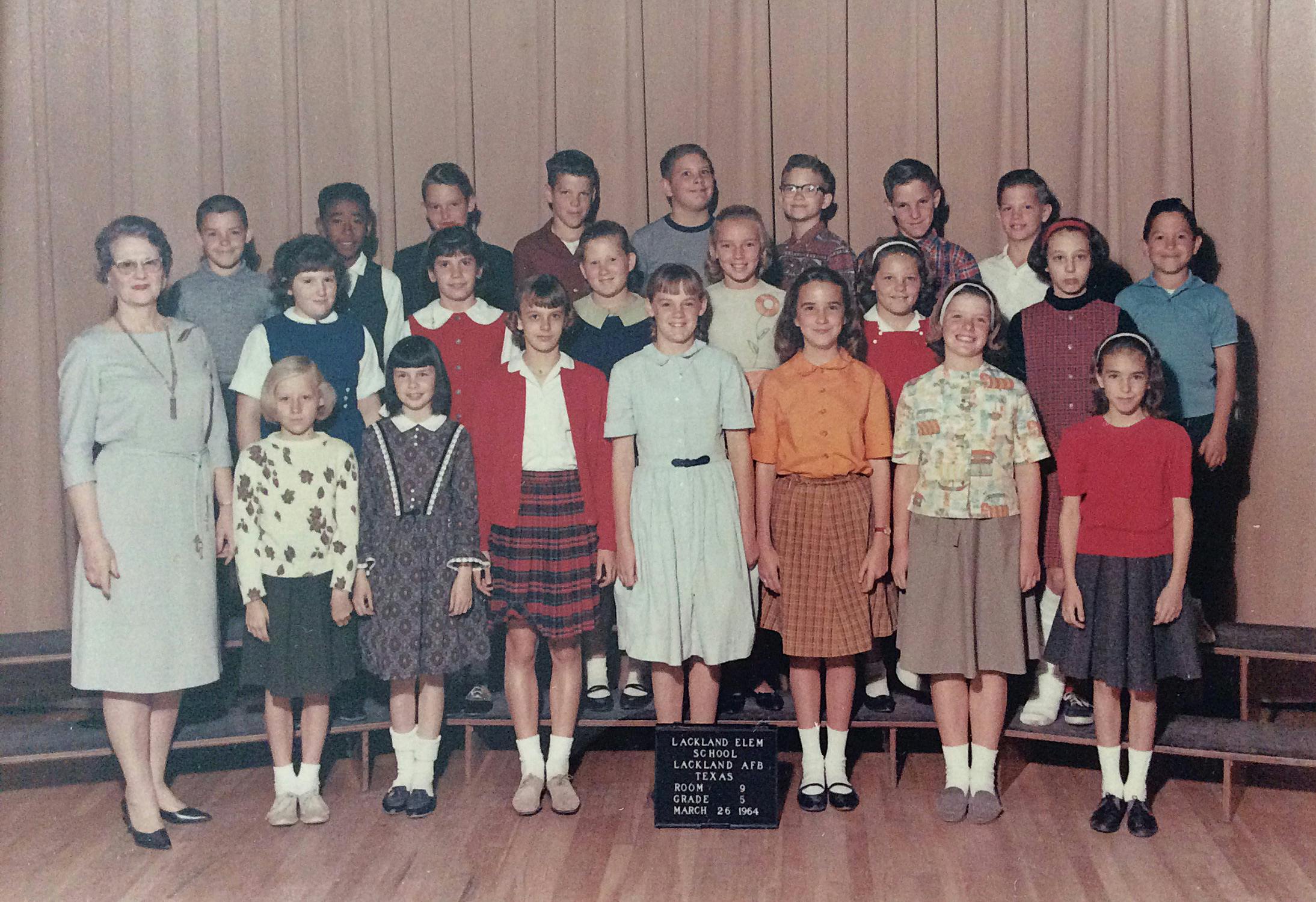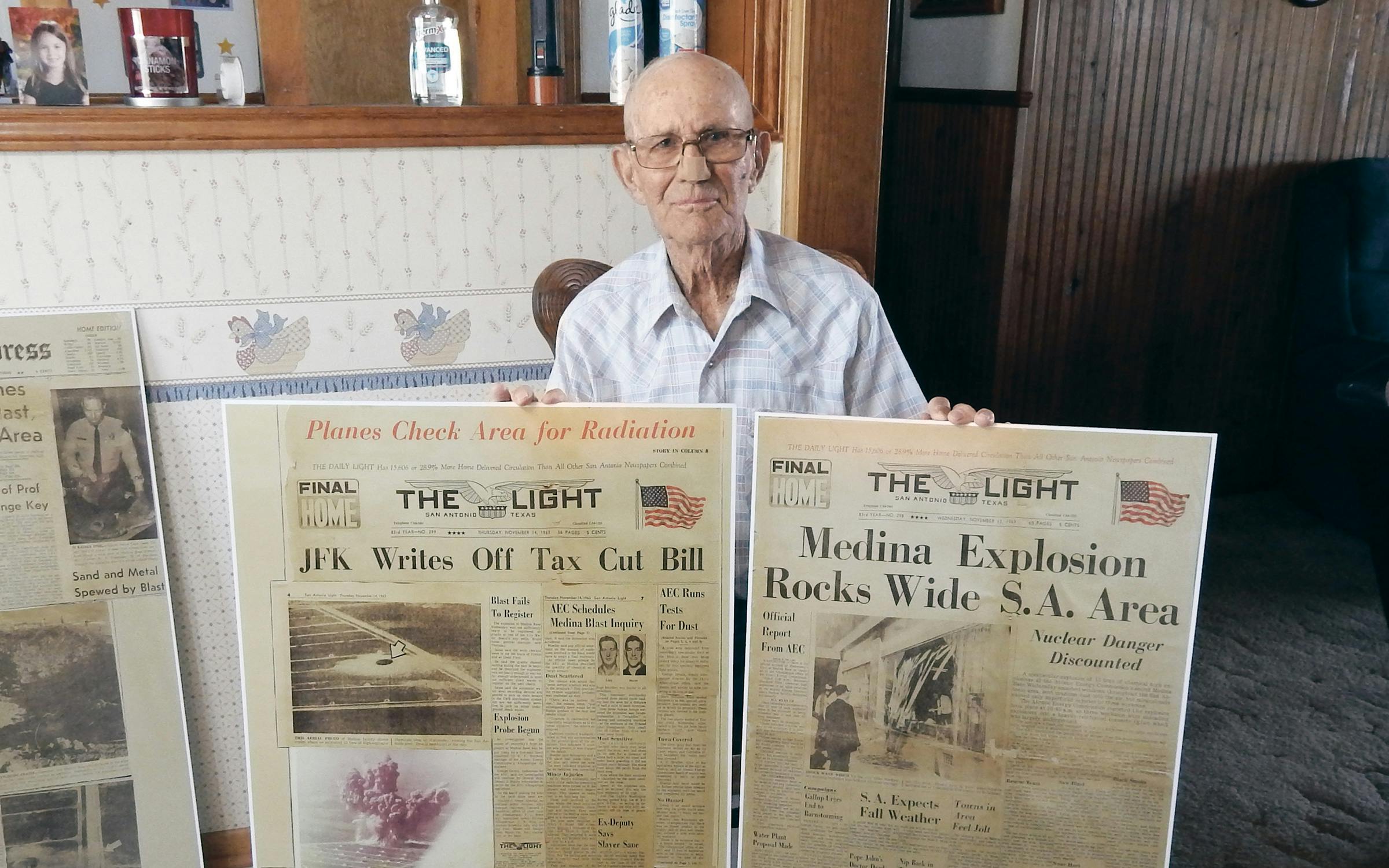On the clear, cool morning of November 13, 1963, a convoy flanked by blue Air Force police cars with flashing lights turned off the tarmac at Kelly Air Force Base, southwest of downtown San Antonio. It wound its way carefully across Interstate 410 and into the neighboring Lackland Air Force Base’s Medina Annex, slowly passing a neighborhood made up of new ranch homes.
At the center of the convoy, an ungainly vehicle called a straddle carrier, whose driver sat in a cab high above the roadway, held precious cargo slung between its four wheeled legs. The vehicle resembled a giant spider protecting its eggs.
The convoy drove into Site King, a secret area in Medina where about a hundred humpbacked rectangular bunkers made of fortified steel and concrete, known as “igloos”—each roughly the size of four 2-car garages—served as one of the country’s largest nuclear weapons installations.
The security was required because the convoy was transporting the explosive mechanisms of partially dismantled Mark-7 nuclear warheads, hundreds of which were being taken out of service. Technicians had removed the “pits” of radioactive fissile material from these warheads, leaving behind a round metallic shell of TNT-based baratol and cyclotol explosives, natural uranium (a hard, dense element found in minute quantities in most rocks and soil), and depleted uranium (a widely used metal left over when natural uranium is chemically enriched to make nuclear fuel).
Those spheres, each roughly the size of a beach ball, were studded with detonators that, if a bomb were fully armed and triggered, would initiate a nuclear explosion up to four times more powerful than the one that had destroyed Hiroshima eighteen years earlier. Without the fissile material, these warheads wouldn’t do anything like that. But even so, the explosives left behind would pack a mighty punch if they were ignited.
On this day at Igloo 572, the spheres, each weighing hundreds of pounds, were loaded on a steel pallet, carefully placed on a hydraulic lift, moved past the pair of ten-foot-tall, two-thousand-pound steel doors, and hauled into the dim interior. The igloo was nearly full of the spheres, 209 of them. Stacked along the floor and divided by a narrow aisle down the center, they were, in essence, one gigantic bomb. Civilian contractors Louis Ehlinger Sr. and Floyd Lutz were laying a pallet into place. It was difficult work.
Another contractor, Hilary Huser, was standing just outside the door, logging numbers from the remaining warheads. At 10:24 a.m., he was startled by a sudden loud crack! coming from the igloo and then saw Lutz and Ehlinger heading toward him. He ran.

Life was good for the kids who lived in Lackland’s Medina Annex in the early sixties. “Carefree” is the word many of them use now to recall those days, even though many of their parents were deeply engaged in the struggles of the Cold War. In the mornings, blue Air Force buses took the kids to Lackland Elementary School; in the afternoons, the same buses brought them back to their neat homes and manicured lawns. After school, they would take off on bikes or roller-skate to the pool or get hot dogs and Popsicles at Lackland’s golf club snack bar.
Because the community was integrated, like all military bases, Black and white kids played together in a way that was uncommon. (On trips into San Antonio, the kids would gawk at “Whites Only” signs posted above public drinking fountains.) Officers’ wives attended white-glove afternoon teas and called the kids to weekday supper at five o’clock sharp. At sunset, the soulful notes of “Taps” brought the day to a close. “It was such a sheltered environment,” said Claudia Petroski, now 67, who grew up there. “Parents didn’t worry if we were out riding bikes. Everybody knew everybody. Everyone else’s mom was looking out for you.”
Most of the kids growing up at Lackland were insulated not just from the outside world but also from the base’s grim purpose: preparing to fight a civilization-ending nuclear war with the Soviet Union. Many of them knew that Site King had something to do with nuclear weapons. After all, the droop-winged B-52s that carried thermonuclear bombs on their global readiness missions landed nearby for servicing, and the weapons designed to kill millions of people came in for regular refurbishment at Medina. But the business of fighting a nuclear war was something adults generally didn’t talk to them about.
Site King’s 88 acres were surrounded by three concentric rings of chain-link fence topped with barbed wire, and K-9 units and armed guards patrolled the grounds. For some Air Force kids, that all seemed to promise high adventure. Reachable by way of a hard hike through tangled underbrush and across Medio Creek, the complex exerted an irresistible pull on young Bill McRaven, who lived at 212 Baseview Drive. One day he carried his Roy Rogers cap gun on a mission with his buddies to climb over the first fence around the property, foretelling the commando operations he would later lead as a legendary Navy SEAL commander. (The authorities stopped the kids before they got to the second fence, aborting their mission.) Others, mindful of the barbed wire topping the fences, went low. “We’d just go under the fence,” recalled Floyd Smith, who also grew up on the base at the time. But they never made it all the way into Site King’s center.

Over the span of almost six decades, memories have faltered and blurred, and the question of why one of the warhead assemblies in Igloo 572 sparked off remains frustratingly unanswered. It seems likely that a detonator was accidentally bumped and then ignited, quickly setting fire to the sphere of highly explosive TNT and uranium metal. That’s how the device was supposed to work, after all. Just not inside a storage igloo.
“There’s no direct answer to what caused it that we know of,” insisted Floyd Lutz, who is eighty and owns a water treatment business in San Antonio. “When the igloo was fixin’ to ignite, we were inside setting down those units.” As soon as that loud crack! sounded, he and Ehlinger scampered through the open doorway amid dust and smoke.
“The fire started, so we hauled ass,” Lutz explained. They sprinted past Huser, yelling as they went.
“[They] didn’t have to tell me to run,” said Huser. “They went one way; I went the other down Perimeter Road. I guess it had rained the day before, and I bogged down in a ditch and fell, got back up and turned around and looked, and there was smoke coming off of the igloo’s vent. I was going to go to the next set of igloos to set off an alarm. I got about halfway, and the whole thing blew up.”
Huser, who died this past August, weeks after I last spoke to him, paused and rested his large hands on the carefully folded newspaper clippings and faded photographs spread out on the kitchen table of his modest one-story house near Blanco, in the gently rolling scrubland between San Antonio and Austin. Behind his rimless glasses, he had a thousand-yard stare that took him back more than half a century.
“I didn’t think I was gonna make it to the next row of igloos,” he said softly.
Within a minute, the fire that had started with one sphere ignited all 209 spheres in the igloo, setting off a tremendous detonation. The entire steel-and-concrete igloo and its contents—the hydraulic Yale lift, the steel pallets, and the one-ton steel doors—all went airborne, as did the dirt and layers of rock that lay as far down as 25 feet beneath the surface. Nothing was left but an empty crater more than half a football field wide. Much of the uranium and depleted uranium metal were vaporized into the towering cloud of dust and debris that rose a thousand feet.
As Ehlinger and Lutz ran, the pressure wave struck, throwing them down the road. They got up, started sprinting again, and made it about a hundred yards from the igloo before Ehlinger leaped into a culvert, where he tried to dodge debris. A chunk of concrete smashed into his thigh, leaving a knot that he says is still there.
“We were lucky enough not to be blowed to pieces,” Lutz said. “[The higher-ups] thought we were all goners. Our boss told ’em, ‘Those guys are probably no longer there.’ ”

Huser, stunned by the concussive blast that had ruptured his left eardrum, felt time stretch into slow motion. He had a terrifying moment when he realized that the large chunks of steel, concrete, and rock that had gone airborne were just as quickly going to come back down.
“I stood there for what seemed like five minutes looking in the air to see if I could dodge all that stuff, and I finally decided I couldn’t, and the biggest thing I could find was a little ol’ bush.” He dove under it and curled himself into the fetal position, his arms clutched tightly over his head as chunks of metal and concrete crashed around him.
When it was over, Huser unwound himself, got up, dusted himself off, and looked around. A lethal-sized block of concrete had landed a few feet away. The chain-link fences that enclosed the field of igloos had been blown over by the force of the blast. An old school bus the men had used to travel to and from the main gate had been thrown over on its side and its windows smashed out.
Hilary Huser dove under a bush and curled himself into the fetal position as chunks of metal and concrete crashed around him.
Eyeing the wreckage, Huser staggered on shaking legs to the concrete pad at the doorway of a nearby igloo and sat down, wondering what had become of Ehlinger and Lutz. Pretty soon their boss arrived in a vehicle. “I told him the other two guys run off, and he took off without saying anything,” Huser remembered. After a while, an ambulance showed up, and an attendant opened the rear door. Ehlinger and Lutz were inside.
The blast also shook Lackland Elementary School, where kids on the playground saw a cloud of smoke and debris rising over Medina Annex. “We thought World War III had started,” said Bill Manrow, then a seventh grader. “We were all scared s—less.” Sirens were going off, windows were broken in the Medina housing complex, and residents were rushing into the street to see what was going on. Many of the adults were terrified that a lethal dose of radiation had been released. It had been only a year, after all, since the United States had halted almost two decades of aboveground nuclear testing, which had showered Americans and others with radioactive fallout. “People fled the scene in panic,” the San Antonio Light reported later that day. Though there was no official evacuation, the roads around the base were jammed bumper to bumper.
The damage was hardly limited to the base. A dozen miles across the city, residents on San Antonio’s North Side reported dishes being thrown from shelves and wall decorations dashed to the floor. The plate-glass window fronting the Continental bus station on Broadway, about thirteen miles from Lackland, was blown in. Elsewhere, according to the Light, a parrot in a birdcage was knocked to the floor but emerged unhurt. A woman named Dora Aguilar was on the phone about a mile from the blast. “I was talking and the explosion simply blew the phone out of my hand,” she told the Associated Press. All over the city, the blast drew people out into the streets to gape at what they later swore was a mushroom-shaped cloud with a cap that was miles wide. (Photographs taken that day don’t show a mushroom-shaped cloud.)
When the explosion happened, Hilary Huser’s wife, Mary, had just arrived at the Model Market, on Vance Jackson Road, eleven miles from the blast. The store’s plate-glass window had bulged in from the pressure wave but hadn’t broken. She then went to another store, where the TV was reporting that there’d been an explosion at Medina Annex. Shocked, Mary picked up a bottle of liquor on the way home so that she and Hilary could celebrate what she hoped had been his narrow escape.

Given that the blast occurred at a nuclear weapons facility in sight of a major American city at a time when the country was obsessed with civil defense, the folks at Lackland might have expected a fast and efficient government response. If they did, they were surely disappointed. The phone lines at Lackland AFB were quickly jammed by panicked callers, which meant the authorities couldn’t get through. So the Texas Department of Public Safety’s communications center, in Austin, assumed the role of coordinating much of the response, as best it could from nearly a hundred miles away.
There was a tremendous amount of confusion. Local civil defense director Martin Ester told reporters that the blast severely “shook up the town”—figuratively speaking—resulting in a flood of “pretty weird tales” and “utterly ridiculous” rumors. One report received by the DPS center from its district headquarters said that only “chemical” explosives were involved. Then came a more alarming—and erroneous—message: enriched uranium-235 had been stored in the igloo. Another message, hardly reassuring, said that “normal” uranium was involved and that it might have been carried downwind. A radio station reported that it was probable that a nuclear reactor had blown up. Some people thought that the United States and the Soviet Union had finally gone to war.
A radio station reported that it was probable that a nuclear reactor had blown up. Some people thought that the United States and the Soviet Union had gone to war.
The state’s Division of Occupational Health and Radiation Control, in Austin, later complained that “there was little or no authoritative information available to the division’’ the entire day. The division dispatched staff members from Austin to collect soil and vegetation samples to test for radiation. Because the car didn’t have a two-way radio, they drove south, unaware of what they were getting into.
For most of the day, officials had no way of knowing “whether or not there was danger to the surrounding population or if assistance was needed on the base itself,” the Disaster Research Center at Ohio State University later observed. Telephone problems also plagued the San Antonio Health Department, which, for reasons that have never been explained, couldn’t make outgoing calls. “For some thirty minutes or more, which was a most important period of time, they had little or no information,” Raymond T. Moore, the regional director of radiological health for the U.S. Public Health Service, wrote in a memo to his boss two days later.
The authorities did address one issue quickly: the question of whether dangerous radiation had been released. Within hours of the blast, technicians had already gathered air, water, and soil samples and, they said, determined that no radiation above normal background levels was detected. Further analysis by a Public Health Service radiological lab confirmed that “no significant contamination” had been released.
How was that possible? The explanation is that the explosion was not, strictly speaking, a “nuclear” blast. Because the radioactive fissile core of each sphere had already been removed, all that was left—other than the TNT-based explosives—were the natural uranium and the depleted uranium, neither of which was dangerously radioactive.
The TNT itself was enough to cause a massive explosion but not the nuclear nightmare that so many feared.

Yet as the years have gone by and Americans have become more skeptical of what their government tells them, some of the people who grew up at Lackland have wondered if they’ve gotten the full story about the after-effects of the explosion.
The children of Lackland Elementary School dispersed as their Air Force parents were transferred or deployed, and they eventually left their homes in San Antonio and went their own ways. But many of them remain such good friends that they have occasional reunions. The most recent one was held last year, in San Antonio.
In the spacious lobby of the historic Menger Hotel, a stone’s throw from the Alamo, ten Lackland alumni, a few of their spouses, and one of their teachers gathered over scrapbooks and old issues of the Junior Talespinner, the school’s newspaper. They shared prosaic memories: the four-foot rattlesnake one of the kids brought home from the woods around Site King, the secret preteen crushes, and the awkward dances at the youth center.
Oddly, most of the former Lackland kids in attendance whom I talked with said that the explosion hadn’t had a significant effect on their lives. When pushed, they spoke of the various traumas of the sixties—the assassinations, the race riots, the friends and family lost in Vietnam—and said they regard that day’s events as inseparable from those larger forces. The explosion was just another event in a decade that left them, and much of the country, reeling.
As they reminisced about their years at Lackland, they also mentioned, sadly, as people their age do, those who are gone. At least five close classmates have died: two from brain tumors; two, in their early sixties, from other cancers; and one from a heart attack. Two other classmates currently have cancer. Inevitably, the people gathered there wondered if the explosion of Igloo 572 had something to do with these deaths and illnesses. “When we started to see all these people with cancer, we started wondering if there wasn’t some connection,” said Jane Vaughn, now 66, who was 9 at the time of the explosion.
Over the past year, I’ve worked to get an answer to that question. One problem: it’s hard to know if the number of Lackland alums with cancer is unusual. Military families frequently move around, so it’s difficult to track down every student who would have been there at the time. I’ve managed to contact fifty of the likely hundreds of children who passed through Lackland Elementary School during the early sixties, hardly enough to do a proper epidemiological study. I’ve dug up reams of technical reports on the explosion and its aftermath, including the original files of the Atomic Energy Commission and analyses of the air, water, and soil sampling done immediately after the explosion and in the days and years afterward. At Lackland in 2002, 2009, and 2010 the Air Force commissioned studies of possible radiological contamination of the soil at the site. Each of the studies found that any contamination was below safe limits.
Last summer I forwarded all of that material to Sheldon Landsberger, a professor of nuclear and radiation engineering at the University of Texas at Austin who serves on the board of the Journal of Environmental Radioactivity. Landsberger didn’t see any evidence of contamination at Lackland dangerous enough to cause cancer. “There’s no smoking gun,” he told me. “It’s hard to predict that cancer would come from this explosion.”
Still, even if there was no epidemiological significance to the explosion, the violent destruction of a nuclear weapons bunker in a major city is the sort of historical event that one would think would live on in Texans’ memories decades later. And yet the Lackland explosion has been forgotten by almost everyone but those who experienced it. Perhaps that’s because the story, in the end, is somewhat anticlimactic; it was a seemingly worst-case scenario that turned out to be not that bad after all. It started with a bang and ended with a whimper.
Or perhaps the Lackland explosion has been lost to history because it was soon overshadowed by a much more momentous event.
On November 21, eight days after the blast, Air Force One landed at San Antonio International Airport, and President John F. Kennedy and first lady Jacqueline Kennedy descended to be greeted by a delirious public. Crowds of people wearing their Sunday best leaned out of windows and balconies and waved and cheered as a motorcade sped the president, the first lady, and Texas governor John Connally and his wife, Nellie, through downtown and out to Brooks Air Force Base to dedicate a new aerospace medical facility.
The Lackland Elementary School kids were bused over to hear the president speak, and afterward, Claudia Petroski and her friend Sally Wolter McLaughlin unexpectedly ran into JFK and Jackie waiting at their car. Petroski remembers Jackie, who must have realized that they had been part of the audience, saying, “Oh Jack, look—the children!” Jackie and the president shook hands with them. “She had her white gloves on,” Petroski said. “I idolized her.”
Later that day the Kennedys flew to Houston and then on to Fort Worth, where they stayed overnight. The next morning, November 22, they boarded Air Force One once again and took off for Dallas.
This article originally appeared in the November 2020 issue of Texas Monthly with the headline “We Thought World War III Had Started.” Subscribe today.
- More About:
- Texas History
- Longreads
- JFK
- San Antonio







